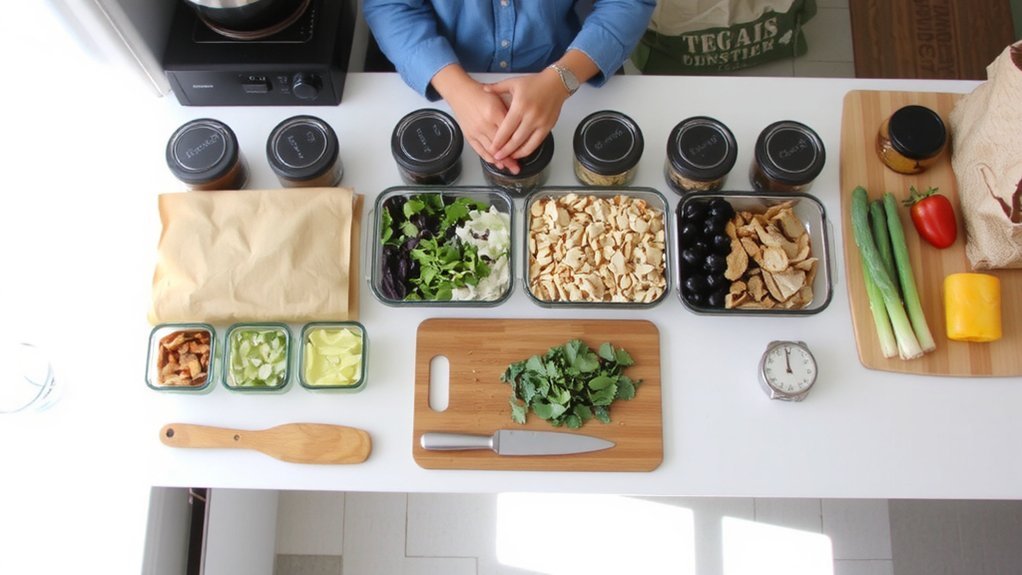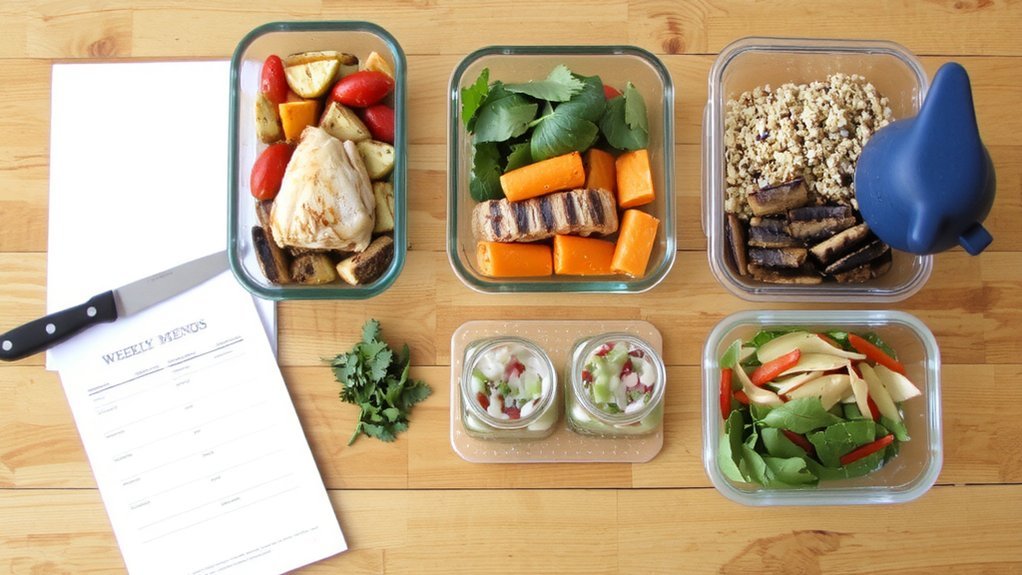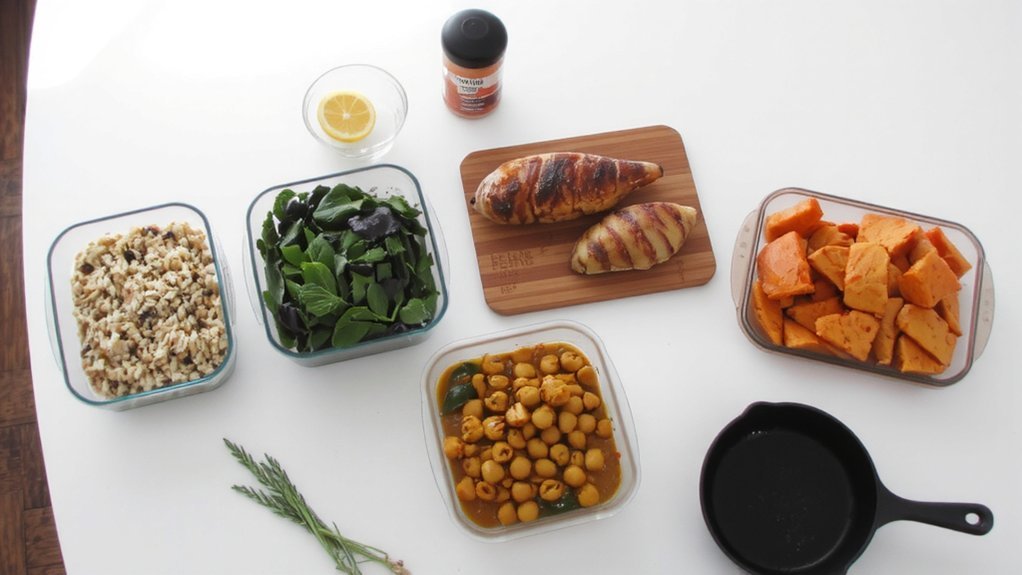You can make weekly meal prep simple and sustainable with a few smart choices. Pick a prep day, choose 3–5 repeatable meals, and batch-cook proteins and grains. Prep breakfasts and snacks in advance so weekdays run smoothly, and you’ll save time, money, and stress—here’s how.
Decide on Prep Day and Frequency

If you want meal prep to stick, pick a consistent prep day and how often you’ll cook—weekly works for most people, but twice a month or midweek top-ups can suit busy schedules.
Choose a day when you have a reliable time block aligned with grocery deliveries or market hours.
Consider energy levels: if evenings drain you, prep on weekends or mornings.
Match frequency to how long food stays fresh and to storage; cook less often if you freeze portions.
Start small—batch staples and components rather than full meals—so you adjust without overwhelm. Use a calendar reminder and set up a simple workflow: wash, chop, cook, store.
Over time you’ll refine timing and tasks, making prep efficient and sustainable. You’ll save several hours each week.
Create a Simple Weekly Menu

Because a clear menu cuts decision fatigue, plan three to five core meals you’ll rotate and stretch into lunches and breakfasts.
Pick meals that share ingredients so you buy less and reuse components—grains, proteins, vegetables and a versatile sauce.
Assign theme nights (Meatless Monday, Taco Tuesday) to speed choices, but keep one flexible night for leftovers or takeout.
Note portion counts and designate which meals freeze or refrigerate well. Schedule when you’ll reheat or combine elements for quick assembly. Add simple breakfasts and snacks that use the same staples. Write the week on a calendar or meal-planning template and sync it with your shopping list. Review the plan briefly before shopping to avoid surprises. Adjust portions during the week based on appetite and schedule.
Choose Recipes for Batch Cooking

When you choose recipes for batch cooking, pick ones that scale up easily, share ingredients, and reheat or freeze without falling apart. Choose a few core formulas — roasted vegetables, grain bowls, soups, sheet-pan proteins — that adapt to spices and sauces so you avoid monotony.
Favor recipes with similar cook times and temperatures to streamline oven or stove use. Prioritize recipes that separate components (starches, proteins, sauces) so you can mix-and-match through the week.
Check textures: creamy, saucy, and sturdy items usually survive freezing; leafy salads and delicate toppings don’t. Consider dietary needs, portion sizes, and simple seasoning tweaks.
Test one batch before committing to a full week, and note packing and reheating instructions for consistency. You’ll save time and reduce stress daily.
Plan Grocery Shopping Efficiently

Before you head out, take inventory of your pantry and fridge and turn your week’s recipes into a single, prioritized shopping list.
Group items by store section — produce, dairy, proteins, frozen, pantry — so you move efficiently through aisles.
Note exact quantities and package sizes to avoid waste and duplicate buys.
Check your phone for store coupons, digital loyalty deals, and weekly ads; match coupons to items on your list.
Plan meals around perishables you’ll use early in the week and buy versatile staples like rice, canned tomatoes, and herbs.
Stick to the list to curb impulse purchases, bring reusable bags, and schedule a quick time block for shopping when stores are less crowded to save time and review receipts for mistakes daily.
Prioritize Long-Cooking Items First

After you’ve shopped and grouped ingredients, start meal prep by tackling the items that require the most time and heat.
Put soups, stews, braises, and slow-roasted vegetables on first so they can simmer or roast while you handle quicker tasks.
Preheat ovens and set slow-cooker or pressure-cooker programs before chopping; this saves idle minutes.
Stagger start times so pots finish near when you’ll assemble meals, preventing overcooking.
Use timers and thermometer checks to ensure doneness without babysitting.
While long cooks progress, prep salads, sauces, and quick sides.
Cool large batches safely: shallow containers, fridge within two hours.
Label contents and date them.
Prioritizing long cooks reduces stress, creates flavor depth, and frees time later in your prep flow.
You’ll thank yourself during the week.
Batch Cook Proteins and Grains
Cook proteins and grains in larger batches so you can mix and match meals all week.
Choose versatile proteins—chicken thighs, ground turkey, tofu, beans—and grains like brown rice, quinoa, and farro.
Season simply for flexibility (salt, pepper, garlic, citrus) and reserve a few jars of sauces to change flavors later.
Portion into meal-sized containers or freezer bags; label with date and contents.
Cool quickly: spread rice or meat on a shallow pan before refrigerating to stay safe.
Reheat only what you need; gently warm proteins to avoid drying and bring grains to steaming hot.
Freeze extra portions for up to three months, thaw overnight in the fridge, and use within 24 hours of thawing.
Keep a simple inventory so you rotate stock without waste.
Prep Vegetables, Snacks, and Breakfasts
Prepping a week’s worth of vegetables, snacks, and breakfasts saves you time and keeps your meals flexible and healthy.
Start by washing and chopping an array of vegetables—crisp carrots, bell peppers, cucumbers, and leafy greens—for quick salads and stir-fries.
Roast tougher veggies like sweet potato and broccoli for easy reheats; steam or blanch green beans and asparagus to preserve texture.
Put together snack kits with nuts, fruit, hummus, and cut veggies for grab-and-go energy.
For breakfasts, batch-make versatile options: egg muffins, overnight oats, yogurt parfaits, and frozen smoothie packs with fruit and spinach.
Mix flavors with spices, herbs, and dressings so you won’t get bored.
Tweak recipes based on cravings and seasonal produce regularly.
Portion, Label, and Store Meals Properly
While you’re portioning meals, divide them into single-serving containers so you grab exactly what you need, cut down waste, and make reheating simple.
Choose containers that fit your meal: shallow for salads, microwave-safe for leftovers, leakproof for liquids.
Use consistent portion sizes so calories and macronutrients stay predictable.
Label each container with the contents and date; a simple masking-tape label and permanent marker work well.
Store meals in fridge for three to four days; freeze extras in airtight, freezer-safe containers for up to three months.
Cool hot food before sealing to preserve texture and safety.
Stack containers to maximize space, and place ready-to-eat meals at eye level so you’ll reach for them first.
Include reheating times and temperatures on labels to protect meal quality.
Build a Sustainable Prep Routine
Establishing a simple, repeatable routine makes weekly meal prep stick: pick one or two consistent days and time blocks that fit your life, plan a rotating set of meals so you don’t burn out, and create a checklist for shopping, prep, and cleanup so nothing gets skipped.
Set realistic goals — decide how many meals you want prepped and which components you’ll batch-cook.
Prep tasks that repeat weekly (grains, proteins, chopped veg) first; assemble items.
Use timers and labeled containers to streamline, avoid decision fatigue.
Track what works in notes so you refine portions and timing.
When energy’s low, simplify: double a favored recipe or use pre-washed greens.
Stick to routine for cycles before changing it; consistency builds savings in time, money, and stress.
Conclusion
Pick a consistent prep day, plan three to five core meals that share ingredients, and make a shopping list grouped by store sections. Cook long items first, batch-cook proteins and grains, and prepare vegetables and breakfasts in advance. Portion into microwave-safe, labeled containers, refrigerate meals for three to four days and freeze extras, and note reheating instructions. Start small; you’ll use simple recipes that scale and set calendar reminders to save time and cut waste.